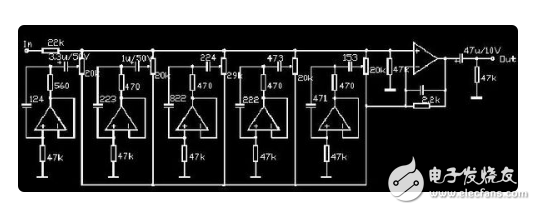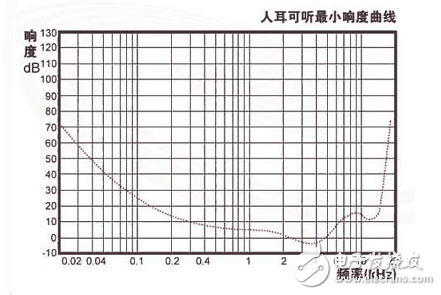Equalizer (equalizer) Communication system, correct the transmission channel amplitude frequency characteristics and phase frequency characteristics of the components. The sine wave with frequency f is sent to the transmission channel, and the characteristic that the amplitude ratio of the output voltage to the input voltage changes with f is called the amplitude-frequency characteristic, referred to as the amplitude-frequency characteristic; Called the phase frequency characteristic, referred to as the phase frequency characteristic. The signals transmitted by various transmission channels are generally composed of components with different frequencies. Within the range of the signal frequency band, if ①the amplitude-frequency characteristic of the channel is a constant value; ② the characteristic that the phase φ changes with f is a straight line, which can be written as
¢ (f) = 2πft + θ, t is a constant; ③θ (called phase intercept) is equal to nπ, n = 0, ± 2, ± 4, ..., then the signal waveform will not be distorted after transmission. Condition ①makes different frequency components have the same output input amplitude ratio after transmission, and conditions ② and ③ make them have the same time delay. But the actual channel often does not meet the above conditions, so the signal is distorted. If the distortion exceeds the allowable amount, an equalizer must be used to correct the channel characteristics.
The requirements for equalization are related to the nature of the signal. Since the human ear is insensitive to phase, when transmitting analog telephone signals, only the amplitude-frequency characteristics of the channel are required. When transmitting TV signals, the amplitude and phase frequency characteristics of the channel are required, otherwise the image will be distorted. When the digital signal is transmitted in the baseband, the amplitude and phase frequency characteristics are required, because the waveform distortion will generate inter-symbol interference and increase the bit error rate. When the digital signal carrier is transmitted, there is no requirement for the phase cut in the channel phase frequency characteristic, because the phase reference is not needed when receiving the digital frequency modulation signal, and the phase reference can be solved by the carrier recovery circuit when receiving the digital phase modulation signal. In this way, only the amplitude-frequency characteristics and delay-frequency characteristics are required during carrier transmission.

The role of the equalizer is to adjust the strength of signals of different frequencies.
Sound as a wave has three elements: amplitude, frequency, and phase. The amplitude determines the size of the sound, and the frequency determines the pitch of the sound. The actual sound is often not a single frequency wave, but a wave of various frequencies is superimposed to form a unique sound.
y = Asin (wt + fi) + A0 (single frequency sound wave description)
y = A1sin (w1t + fi1) + A2sin (w2t + fi2) +. . . (Actual sound wave description)
The difference in sound is that sound signals of different frequencies have different intensities. The equalizer is based on this principle.
The equalizer can automatically separate signals of different frequencies and adopt different degrees of amplification or reduction to change the sound effect. At present, the equalizer has both hardware direct implementation (such as SAA7709 hardware Equalizer) and software implementation (such as thousands of mute). Of course, in principle, there can be both an equalizer for processing analog signals and an equalizer for processing digital signals.
The equalizer generally divides the frequency range (20Hz-20KHz) that people can hear into multiple frequency bands, and amplifies or reduces the sound signals of different frequency bands to different degrees (gain or negative gain). If Qianqian Mute is divided into 10 frequency bands. The SAA7709 hardware equalizer has 20 hardware units. When the 2X10 mode is used, the sound signal can be divided into 10 frequency bands (secTIon), and when the 4x5 mode is adopted, it can be divided into 5 frequency bands (secTIon).
The principle of sound effect equalizer EQIn audio equipment, an equalizer is an electronic device that can adjust the amplification of electrical signals of various frequency components separately. It can compensate for the defects of speakers and sound fields by adjusting electrical signals of various frequencies, and compensate and modify various sounds. Source and other special functions, the equalizer on the general mixer can only adjust the high-frequency, intermediate-frequency and low-frequency electrical signals separately.
Strictly speaking, we should first use the equalizer to correct the sound according to the frequency response curve of the sound, that is, the frequency response curve of the sound is not originally a straight line, but in order to truly restore the sound, we can adjust the original through the adjustment of the equalizer The curve of becomes a straight line. But most friends do not have this condition, and do not know the frequency response curve of headphones or earplugs, so we can only adjust according to our hearing.
First look at the role of each part of the equalizer after segmentation:
1. 20Hz--60Hz part
This period of improvement can give the music a strong feeling, giving people a very loud feeling, such as thunder. It is a powerful feeling in music. If the lift is too high, it will be cloudy again, resulting in poor clarity, especially for audio equipment with poor low frequency response and excessive low frequency.
2. 60Hz--250Hz part
This section is the low-frequency structure of music. They contain the basic sounds of the rhythm part, including the main sounds of the fundamental and rhythm sounds. The ratio between it and the high school sound constitutes the balanced characteristics of the tone structure. Raising this segment will make the sound plump, and excessive lifting will make a rumble. Attenuating these two sections will make the sound thin.
3. 250Hz--2KHz part
This section contains the low-frequency harmonics of most musical instruments. If the boost is too much, the sound will be like the sound of the phone. Excessively increasing 600Hz and 1kHz will make the sound resemble the sound of a speaker. Increasing 3kHz too much will mask the recognition sound of speech, that is, slurred speech, and make the lip sound "mbv" difficult to distinguish. Excessively increasing 1kHz and 3kHz will make the sound metallic. Since the human ear is more sensitive to this frequency band, this segment is usually not adjusted. Excessively increasing this segment will cause hearing fatigue.
4. 2KHz--4kHz part
This frequency is an intermediate frequency. If it is raised too high, it will mask the recognition sound of speech, especially if the 3kHz is raised too high, it will cause hearing fatigue.
5. 4kHz--5KHz part
This is a frequency band with a sense of presence, which affects the clarity of language and musical instruments. Raising this frequency band makes people feel that the distance between the sound source and the listener is a little closer; attenuating 5kHz will make the distance of the sound farther away; if it is raised by 6dB at about 5kHz, it will make the entire mixed sound sound The power is increased by 3dB.
6. 6kHz--16kHz part
This band controls the brightness, macro brightness and clarity of the sound. Generally speaking, raising these paragraphs makes the sound magnificent, but not clear. It is impossible to cause the tooth sound to be too heavy. The sound becomes clear when it is attenuated, but the sound is not magnificent.
The equalizer can also be set according to the curve of the listening limit, so that the ear can feel the sound most easily, which is the most natural and best! As shown in the figure below, we increase the low-frequency and high-frequency DB numbers.

This allows low frequencies and high frequencies to be felt naturally by the ear, which means that the optimal EQ setting should match this graph.
The CD recorded the edited sound source signal very well when it was recorded, and the sound effects were adjusted when the CD was made, so we can think that no compensation is needed. mp3 is not the same. When compressing, there will be losses in the three parts of high, middle and low frequency. Generally speaking, the high and low ends are lost, while the middle frequency part is largely retained. So the approach I took was to adjust by comparing CD and mp3 file playback.
Optical Rotary Sensor,Custom Encoder,Optical Encoder 6Mm Shaft,Handwheel Pulse Generator
Jilin Lander Intelligent Technology Co., Ltd , https://www.jilinlandermotor.com